Medication Nonadherence and the Risks of Hospitalization, Emergency Department Visits, and Death Among Medicare Part D Enrollees With Diabetes
The authors are affiliated with the University of Mississippi School of Pharmacy, in University, Miss. Dr Yang is assistant professor in the department of pharmacy administration.
Diabetes is a complex metabolic disorder that often requires multiple drugs to manage its symptoms and comorbid conditions, such as hypertension and hypercholesterolemia. Diabetes is also a chronic disorder that requires patients to follow the treatment for as long as the disorder persists, which is often for the rest of their lives.1,2 Therefore, adherence to prescribed medications is crucial to therapeutic success.
The clinical benefits of intensive diabetes control using hypoglycemic agents, angiotensin-converting enzyme inhibitors (ACEIs) or angiotensin II receptor blockers (ARBs), and 3-hydroxy-3-methylglutaryl coenzyme A reductase inhibitors (statins) in managing diabetes and preventing diabetes-related complications have been well established in clinical trials and longitudinal studies.3-10 However, adherence to treatment regimens with these medications among patients with diabetes remains suboptimal. Recently, a meta-analysis on adherence to oral hypoglycemic agents, antihypertensive drugs, and drugs for dyslipidemia showed that the average adherence rate was 59%-that is, only 59% of patients took their medication for more than 80% of days on a treatment regimen.11
Some studies have examined the relationship between medication adherence and patient outcomes by examining clinical parameters (such as glycated hemoglobin, blood pressure, and cholesterol levels) and clinical events (such as hospitalization and death) using claims data. Medication adherence was typically measured using the proportion of days covered (PDC) or the medication possession ratio (MPR), with PDC being used with increasing frequency.12-17
In general, poor adherence to long-term medication regimens may limit the effectiveness of pharmacological therapies and may have a negative effect on patient outcomes.15,16,18-23 One study found that among diabetic patients in a managed care organization, a 10% increase in nonadherence to hypoglycemic agents and statins was associated with an increase of 0.14% in glycated hemoglobin levels and an increase of 4.9 mg/dL in low-density lipoprotein cholesterol levels.22
In a study of managed care enrollees with diabetes, Ho and associates16 reported that the risks of
hospital admissions and death were increased in nonadherent patients compared with those in adherent patients, even after adjusting for age, sex, and comorbidities. There is reason to believe that among Medicare Part D enrollees, poor medication adherence may also be related to increased risks of a variety of adverse health outcomes, including hospitalizations, emergency department (ED) visits, and death.
The objective of the study we describe here was to examine the associations between nonadherence with oral hypoglycemic agents, ACEIs/ ARBs, and statins and subsequent all-cause hospitalizations, ED visits, and death among Medicare Part D enrollees with diabetes. Medication adherence was estimated on the basis of PDC, and nonadherence was defined as PDC of less than 80%.
MethodsPatient selection. This longitudinal, retrospective cohort study was conducted using Medicare claims data from 6 states: Alabama, California, Florida, Mississippi, New York, and Ohio. These states were chosen, first, because they are geographically dispersed and provide a cross-section of the United States, and second, because we wanted to ensure an adequate population of beneficiaries to obtain an adequate number of beneficiaries who have diabetes. These states (particularly California, Florida, and New York) contain large numbers of Medicare beneficiaries. In addition, Alabama and Mississippi were included to enable comparisons of like states because they were relatively homogeneous with regard to their Medicare populations.
Patients included in the study were Medicare Part D beneficiaries who had at least 1 pharmacy claim for dates of service from January 1, 2006, through June 30, 2006. For all beneficiaries enrolled in Part D, their Part A, Part B, and Medicare beneficiary data from October 1, 2005, through March 31, 2007, were retrieved. Beneficiaries without a single Part A or B claim from October 1, 2005, through March 31, 2007, were excluded because it could not be verified that these beneficiaries had been covered under Part A and Part B.
Duplicate claims were handled by retaining only the first record in case of duplication. Data were fully de-identified after merging Part A, Part B, and Medicare beneficiary files with Part D claims for all beneficiaries. Data analysis, research, and analytical procedures were approved by the Institutional Review Board and were deemed to be compliant with the Health Insurance Portability and Accountability Act.
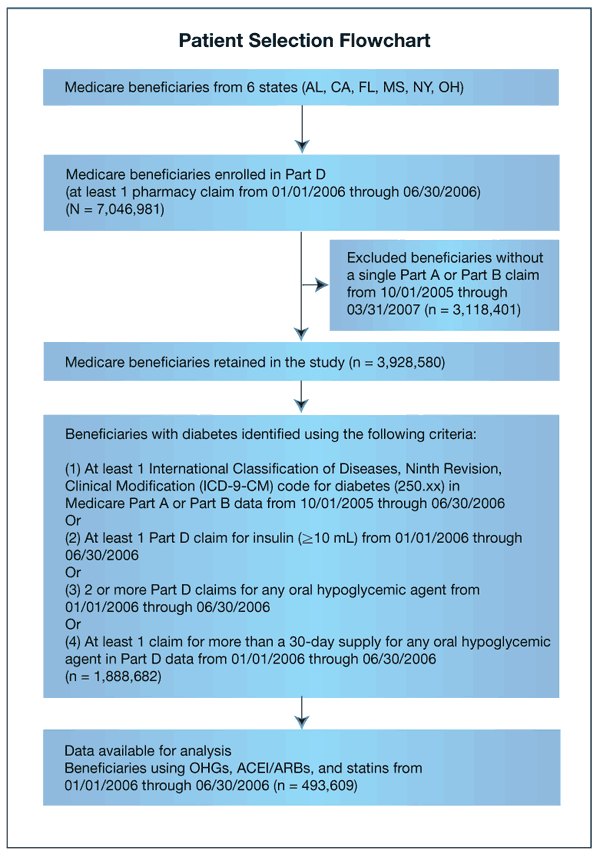
Inclusion criteria. Medicare beneficiaries were identified as having diabetes if they had (1) at least 1 International Classification of Diseases, Ninth Revision, Clinical Modification (ICD-9-CM) code for diabetes (250.xx) in Medicare Part A or Part B data from October 1, 2005, through June 30, 2006; (2) at least 1 claim for insulin (10 mL or more total) in Part D data; (3) 2 or more claims for any oral hypoglycemic agent; or (4) at least 1 claim for more than a 30-day supply for any oral hypoglycemic agent in Part D data from January 1, 2006, through June 30, 2006 (Figure). Since we intended to examine the effect of adherence on patient health outcomes and not to compare users with nonusers of these medications, only beneficiaries who used all 3 classes of medications (hypoglycemic agents, ACEIs or ARBs, and statins) were included.
Beneficiaries with at least 1 pharmacy claim in each of the 3 classes of medications in the first 6 months of 2006 formed the study sample. All medication use was identified by matching the drug claims in Part D with National Drug Codes of these medications obtained from the Multum drug database.24 Patient demographics, prescription drug use, medical facility use, comorbidities, and mortality data were obtained for each beneficiary from Medicare Part A, Part D, and beneficiary data.
Measurement of adherence. PDC was used to measure medication adherence and was computed using Part D data from January 1, 2006, through June 30, 2006; PDC of 80% or greater was considered adherent (a dichotomized value often seen in literature).12-17 PDC was calculated as the number of days of medication supplied within the study interval divided by the number of days in the study interval.25
Adherence was measured for 3 classes of medications, oral hypoglycemic agents, ACEIs or ARBs, and statins. For enrollees taking multiple medications within the same therapeutic class, a class PDC was calculated on the basis of actual days covered by any drug from that class. Switching between medications within each therapeutic category during the observation period was treated as continuous use of that class of medication. PDC for ACEI or ARB use was calculated together on the assumption that ACEIs and ARBs are “therapeutically equivalent.”
A summary measure of adherence was computed for each patient as an ordinal variable with 4 levels: (1) adherent to all 3 classes of medications, (2) adherent to any 2 classes of medications, (3) adherent to any 1 class of medication, and (4) nonadherent to any class of medication. This ordinal adherence variable was the major predictor variable in the multivariate analyses.
Comorbidity. Comorbidity was measured using the Deyo-adapted Charlson Comorbidity Index (CCI).26 CCI is a weighted index of 19 conditions that are associated with important health outcomes such as death. Diabetes and diabetes with end-organ damage were excluded while computing CCI for this analysis. All comorbidities were identified by matching the primary and secondary diagnosis codes from Medicare Part A and Part B data from October 1, 2005, through June 30, 2006, with the ICD-9-CM codes for the comorbid conditions described by Deyo and associates.26
Measurement of outcomes. The outcomes studied were at least 1 hospitalization, ED visit, and death for any reason during the follow-up period (July 1, 2006, through March 31, 2007). These 3 outcome measures were dichotomized as hospitalized or not, visited an ED or not, and death or not. For purposes of this analysis, ED visits included only visits that did not result in admission to the hospital. ED visits resulting in admission to the hospital were classified as hospitalization. Data for hospitalizations and ED visits were obtained from Part A data, and data for mortality from Medicare beneficiary files. We hypothesized that lower levels of adherence might result in increased risk of hospitalizations, ED visits, and/or death.
Statistical analysis. Baseline demographics and comorbidity index were compared between patients who were adherent to all 3 classes of medications, those adherent to 2 classes of medications, those adherent to 1 class of medication, and those nonadherent to any class of medication using the χ2 tests for categorical variables and analysis of variance tests for continuous variables.
In the multivariate analysis, logistic regression models were fitted to evaluate the association between medication adherence and all-cause hospitalizations, all-cause ED visits, and all-cause death, adjusting for individual demographic characteristics (age, sex, and race) and CCI. Odds ratios (ORs) and 95% confidence intervals (CIs) were calculated for each independent variable in the multivariate models. To further test the robustness of our findings, sensitivity analyses were performed using a different cut-off value in measuring adherence (PDC = 50%) and treating adherence as a continuous variable rather than an ordinal variable. All analyses were performed using the SAS statistical package version 9.1 (SAS Institute, Cary, NC).
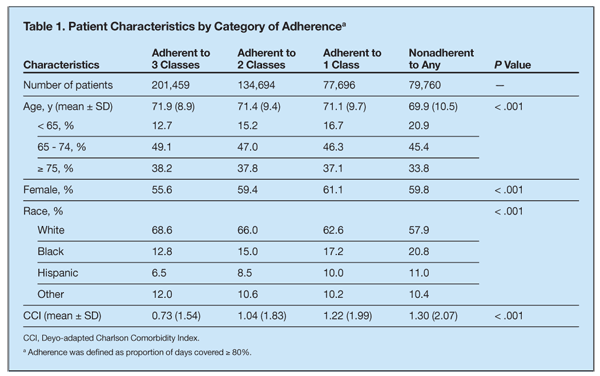
Results
The final study sample consisted of 493,609 Medicare Part D enrollees with diabetes who had at least 1 claim for a hypoglycemic agent, an ACEI/ARB, and a statin during the first 6 months of 2006, accounting for 26.1% of eligible Medicare Part D enrollees with diabetes. Among them, 58.2% were female; 65.2%, white; 15.4%, black; 8.3%, Hispanic; and 11.1%, another race or ethnicity. The mean age was 71.3 (standard deviation, 9.5) years. Among our study population, 40.8% were adherent to all 3 classes of medications studied, 27.3% were adherent to any 2 classes of medications, 15.7% were adherent to any 1 class of medication, and 16.2% were not adherent to any of the 3 classes of medications. The descriptive characteristics of the study population are presented in Table 1.
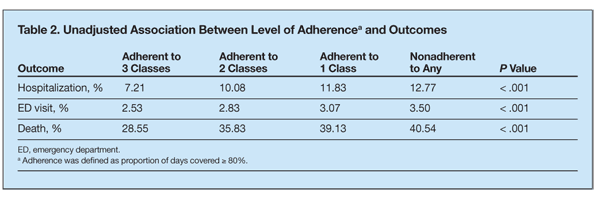
In unadjusted analyses, patients who had lower levels of adherence had higher rates of all-cause hospitalizations, all-cause ED visits, and all-cause death in the follow-up period (Table 2). Table 3 presents the results of multivariate analyses. In multivariate regression models, a lower level of medication adherence was associated with increased risks of all-cause hospitalizations, ED visits, and death, after controlling for confounding variables, including age, sex, race, and comorbidity. For example, compared with patients who were adherent to all 3 classes of medications, patients who were nonadherent to any were 44.6% more likely to be hospitalized for any causes (OR, 1.446; 95% CI, 1.405 - 1.488; P < .001), 32.8% more likely to visit the ED (OR, 1.328; 95% CI, 1.304 - 1.353; P < .001), and 22.6% more likely to die during the follow-up period (OR, 1.226; 95% CI, 1.168 - 1.287; P < .001).
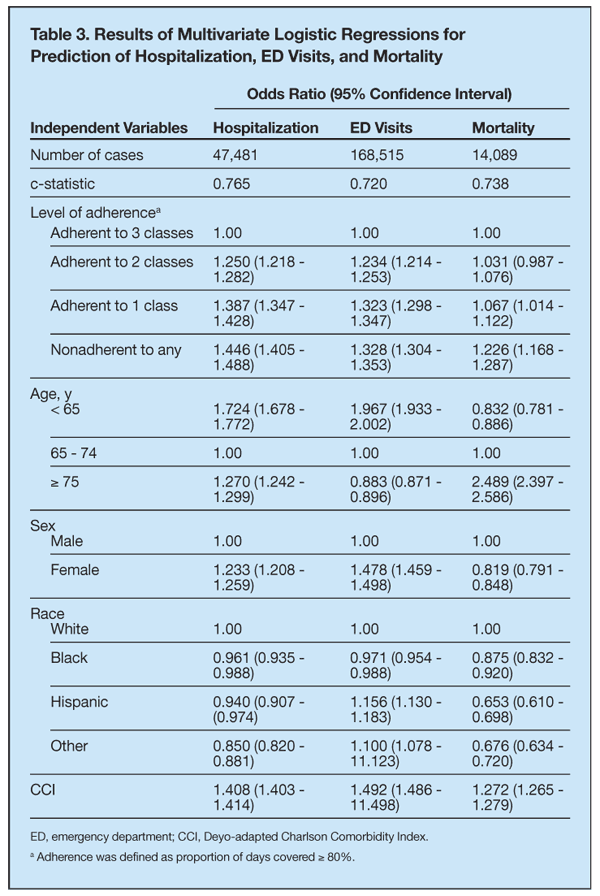
All-cause hospitalization, ED visits, and death also showed significant positive associations with CCI (P < .001). Female gender is associated with increased risk of all-cause hospitalizations and ED visits, but lower risk of death for any reasons. Compared with persons aged 65 to 74 years, those younger than 65 years were more likely to be hospitalized or visit an ED but less likely to die; patients 75 years or older were more likely to be hospitalized or die but less likely to visit an ED.
Results of sensitivity analyses. As presented in Table 4, the results of sensitivity analyses using a different cut-off value (PDC = 50%) for adherence were consistent with our primary findings.
In a second sensitivity analysis, incremental increases in levels of adherence (when adherence level was treated as a continuous vari-able) were also associated with improved health outcomes. With adherence to each additional class of medication (unit = 1 class of medication), there was an 11.8% (OR, 0.882; 95% CI, 0.874 - 0.890; P < .001) reduction in all-cause hospital admissions, a 9.7% (OR, 0.903; 95% CI, 0.898 - 0.908; P < .001) reduction in ED visits, and a 6.0% (OR, 0.940; 95% CI, 0.926 - 0.955; P < .001) reduction in mortality.
Discussion
The objective of this study was to evaluate the association between levels of medication adherence and adverse health outcomes among Medicare Part D enrollees who have diabetes. We found that patients with lower levels of medication adherence had higher all-cause hospitalizations, ED visits, and mortality than patients with higher levels of adherence. This pattern is observed across all 3 outcome measures and when using different operational definitions of adherence. The results persist after controlling for patient demographic characteristics and comorbidity. These findings suggest that current quality improvement interventions should be expanded to include the assessment of medication adherence among patients with chronic conditions such as diabetes mellitus and that efforts should be made to improve patient adherence to prescribed medicines.
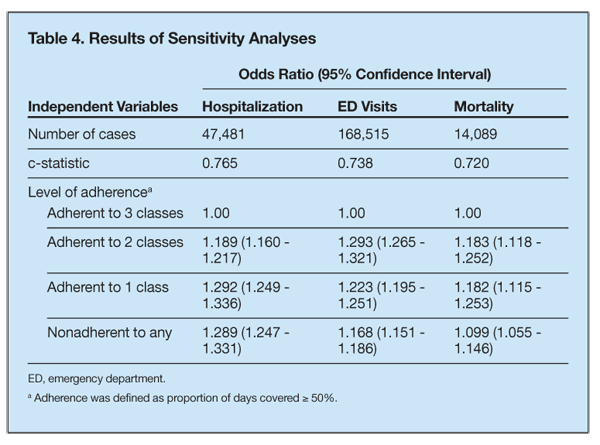
The prevalence of nonadherence in our study was about the same as reported in other studies of medication adherence among patients with diabetes. In our study, approximately 60% of patients with diabetes showed various levels of nonadherence to essential medications, while the reported rate of nonadherence ranged from 10% to 64% in previous studies, depending on the type of medication examined, the population studied, and the method of adherence measurement.27
We also found significant disparities in health outcomes among patients with different levels of adherence. Poor adherence is significantly related to poor health outcomes. These findings expand the literature on the link between medication adherence and health outcomes. Previous studies that assessed the effect of medication adherence among patients with diabetes focused mainly on physiological parameters and limited medical events.16,21,23
A number of factors have been identified that influence medication adherence, including the patient’s comprehension of the treatment regimen and its benefits, regimen complexity, adverse effects, medication costs, and the patient’s cultural beliefs.27,28 Information on some of these variables is unavailable in the Medicare Part D claims data, so it is not possible to account for them in our study. Therefore, caution must be exercised when interpreting the associations between medication nonadherence and the risk of hospitalizations, ED visits, and death, since the associations may not be causal. In addition, this study is observational in nature, making it more difficult to draw definitive conclusions about the causal relationships between medication nonadherence and risk of adverse health outcomes.
Moreover, it should be noted that our observed associations between poor adherence and adverse health outcomes could be attributable to unmeasured confounding factors, such as the “healthy adherer effect,” in which adherent patients in general are more health-seeking than nonadherent patients.29,30 Nonetheless, our findings of substantial differences in the risks of hospitalizations, ED visits, and death provide a good indication of the benefits of improving medication adherence in patients with chronic diseases.
Diabetes is a complex disorder requiring a complex regimen to manage, including lifestyle changes, glucose monitoring, and multiple medications to prevent complications. To our knowledge, our study is one of the very few that evaluated adherence to multiple medications essential to the management of diabetes.16,22 Ho and associates16 studied the effect of medication nonadherence on all-cause hospitalizations and death among patients with diabetes. An average PDC for 3 categories of medications was calculated for each patient. They found that the risks of hospitalization and death were increased in patients who were nonadherent.
In our study, instead of calculating an average adherence, we computed PDCs for individual category of medications and measured adherence at different levels according to whether patients were adherent to none, 1, 2, or all 3 categories of medications. We demonstrated that a higher level of medication adherence was associated with significantly reduced risk of hospitalization, ED visit, and death for any reason. The results suggest that it may be beneficial for health plans to develop targeted interventions to improve medication adherence among patients with diabetes.
In addition to clinical importance, increased adherence to medications may produce economic benefits. A systematic literature review showed that with a 10% increase in MPR, there is an 8.6% to 28.9% reduction in overall health care costs.31 It should be noted that to achieve long-term cost savings through adherence to preventive measures, such as taking statin medications to prevent diabetic macrovascular complications, these preventive measures need to be priced appropriately and delivered efficiently to patients.32-34 Future studies in the Medicare Part D population should directly evaluate the economic effect of nonadherence and should evaluate the effect of the coverage gap in the Part D program (known as the “doughnut hole”) on medication adherence.
Several limitations of our study should be acknowledged. First, our estimation of adherence might have been confounded. From the Medicare administrative claims data used in this study, we were unable to identify exactly when the patient became a candidate for a study medication or when the patient started medication therapy. A study medication could have been prescribed in the middle of the study period, or therapy could have been switched to or from a study medication during the study period, as in switching from an oral hypoglycemic agent to insulin because of inadequate glycemic control. As a result, some patients might have been inappropriately categorized as nonadherent. Our adherence measure for each medication was not adjusted for days of inpatient care during the study period, which could also have led to an overestimation of nonadherence.
Second, we used a pharmacy claim as a proxy for actual medication use. We were unable to determine whether the patient actually took the medication once dispensed. However, previous research has shown that filling a prescription is generally consistent with taking the drug.35 Furthermore, our study was restricted to the Medicare Part D enrollees. Patient demographic, socioeconomic, and clinical characteristics may be different in non-Medicare populations and even among Medicare beneficiaries not enrolled in Part D programs; therefore, adherence to medications may also differ in those populations.
Nonetheless, most other studies that examined the effect of medication nonadherence in patients with diabetes produced similar results. Given the low level of adherence and the significant association between nonadherence and adverse health outcomes, there is certainly a need to identify strategies to improve patient adherence to prescribed medications. Clinicians and health plan managers could play an important role in identifying nonadherent patients and could initiate interventions to increase patient adherence.
Conclusion
Medication nonadherence is prevalent among Medicare Part D enrollees with diabetes, and nonadherence to multiple classes of medications is associated with increased risks of hospitalizations, ED visits, and death from any cause. The findings of this study add to the evidence that medication adherence is necessary to reduce the risk of severe adverse health outcomes. Future studies should focus on various interventions that can improve patient adherence to prescribed medications for better patient outcomes.
References:
References
 1. Rodbard HW, Blonde L, Braithwaite SS, et al; AACE Diabetes Mellitus Clinical Practice Guidelines Task Force. American Association of Clinical Endocrinologists medical guidelines for clinical practice for the management of diabetes mellitus [published correction appears in
Endocr Pract.
2008;14:802-803]. Endocr Pract. 2007;13
(suppl 1):1-68.
 2. American Diabetes Association. Standards of medical care in diabetes-2008.
Diabetes Care.
2008;31(suppl 1):S12-S54.
 3. Effect of intensive blood-glucose control with metformin on complications in overweight patients with type 2 diabetes (UKPDS 34). UK Prospective Diabetes Study (UKPDS) Group [published correction appears in Lancet. 1998; 352:1558].
Lancet.
1998;352:854-865.
 4. Prevention of cardiovascular events and death with pravastatin in patients with coronary heart disease and a broad range of initial cholesterol levels. The Long-Term Intervention with Pravastatin in Ischaemic Disease (LIPID) Study Group.
N Engl J Med.
1998;339:1349-1357.
 5. Intensive blood-glucose control with sulpho-
nylureas or insulin compared with conventional treatment and risk of complications in pa-tients with type 2 diabetes (UKPDS 33). UK Prospective Diabetes Study (UKPDS) Group [published correction appears in
Lancet.
1999;
354:602]. Lancet. 1998;352:837-853.
 6. Adler AI, Stratton IM, Neil HA, et al. Association of systolic blood pressure with macrovascular and microvascular complications of type 2 diabetes (UKPDS 36): prospective observational study.
BMJ.
2000;321:412-419.
 7. Colhoun HM, Betteridge DJ, Durrington PN, et al; CARDS Investigators. Primary prevention of cardiovascular disease with atorvastatin in type 2 diabetes in the Collaborative Atorvastatin Diabetes Study (CARDS): multicentre randomised placebo-controlled trial.
Lancet.
2004;364:685-696.
 8. Hansson L, Zanchetti A, Carruthers SG, et al. Effects of intensive blood-pressure lowering and low-dose aspirin in patients with hypertension: principal results of the Hypertension Optimal Treatment (HOT) randomised trial. HOT Study Group.
Lancet.
1998;351:1755-1762.
 9. Sacks FM, Pfeffer MA, Moye LA, et al. The effect of pravastatin on coronary events after myocardial infarction in patients with average cholesterol levels. Cholesterol and Recurrent Events Trial investigators.
N Engl J Med.
1996;335:1001-1009.
10. Stratton IM, Adler AI, Neil HA, et al. Association of glycaemia with macrovascular and microvascular complications of type 2 diabetes (UKPDS 35): prospective observational study.
BMJ.
2000; 321:405-412.
11. Cramer JA, Benedict A, Muszbek N, et al. The significance of compliance and persistence in the treatment of diabetes, hypertension and dyslipidaemia: a review.
Int J Clin Pract.
2008;62:76-87.  Â
12. Benner JS, Glynn RJ, Mogun H, et al. Long-term persistence in use of statin therapy in elderly patients.
JAMA.
2002;288:455-461.
13. Benner JS, Pollack MF, Smith TW, et al. Association between short-term effectiveness of statins and long-term adherence to lipid-lowering therapy.
Am J Health Syst Pharm.
2005;62:1468-1475.  Â
14. Chapman RH, Benner JS, Petrilla AA, et al. Predictors of adherence with antihypertensive and lipid-lowering therapy.
Arch Intern Med.
2005; 165:1147-1152.
15. Ho PM, Magid DJ, Masoudi FA, et al. Adherence to cardioprotective medications and mortality among patients with diabetes and ischemic heart disease.
BMC Cardiovasc Disord.
2006;6:48.
16. Ho PM, Rumsfeld JS, Masoudi FA, et al. Effect of medication nonadherence on hospitalization and mortality among patients with diabetes mellitus.
Arch Intern Med.
2006;166:1836-1841.
17. Mauskopf JA, Paramore C, Lee WC, Snyder EH. Drug persistency patterns for patients treated with rivastigmine or donepezil in usual care settings.
J Manag Care Pharm.
2005;11:231-251.
18. Balkrishnan R, Rajagopalan R, Camacho FT, et al. Predictors of medication adherence and associated health care costs in an older population with type 2 diabetes mellitus: a longitudinal cohort study.
Clin Ther.
2003;25:2958-2971.
19. Cooke CE, Fatodu H. Physician conformity and patient adherence to ACE inhibitors and ARBs in patients with diabetes, with and without renal disease and hypertension, in a medicaid managed care organization.
J Manag Care Pharm.
2006;12:649-655.
20. Hertz RP, Unger AN, Lustik MB. Adherence with pharmacotherapy for type 2 diabetes: a retrospective cohort study of adults with employer-sponsored health insurance.
Clin Ther.
2005; 27:1064-1073.
21. Lau DT, Nau DP. Oral antihyperglycemic medication nonadherence and subsequent hospitalization among individuals with type 2 diabetes.
Diabetes Care.
2004;27:2149-2153.
22. Pladevall M, Williams LK, Potts LA, et al. Clinical outcomes and adherence to medications measured by claims data in patients with diabetes.
Diabetes Care.
2004;27:2800-2805.
23. Sokol MC, McGuigan KA, Verbrugge RR, Epstein RS. Impact of medication adherence on hospitalization risk and healthcare cost.
Med Care.
2005;43:521-530.
24. Cerner Multum. Lexicon. http://www.multum.com/Lexicon.htm. Accessed October 23, 2009.  Â
25. Peterson AM, Nau DP, Cramer JA, et al. A checklist for medication compliance and persistence studies using retrospective databases.
Value Health.
2007;10:3-12.
26. Deyo RA, Cherkin DC, Ciol MA. Adapting a clinical comorbidity index for use with ICD-9-CM administrative databases.
J Clin Epidemiol.
1992;45:613-619.
27. Rubin RR. Adherence to pharmacologic therapy in patients with type 2 diabetes mellitus.
Am J Med.
2005;118(suppl 5A):27S-34S.
28. Lerman I. Adherence to treatment: the key for avoiding long-term complications of diabetes.
Arch Med Res.
2005;36:300-306.
29. Dormuth CR, Patrick AR, Shrank WH, et al. Statin adherence and risk of accidents: a cautionary tale.
Circulation.
2009;119:2051-2057.
30. Simpson SH, Eurich DT, Majumdar SR, et al. A meta-analysis of the association between adherence to drug therapy and mortality.
BMJ.
2006;333:15.
31. Lee WC, Balu S, Cobden D, et al. Prevalence and economic consequences of medication adherence in diabetes: a systematic literature review.
Manag Care Interface.
2006;19:31-41.
32. Kahn R, Robertson RM, Smith R, Eddy D. The impact of prevention on reducing the burden of cardiovascular disease.
Circulation.
2008;118:576-585.
33. Pletcher MJ, Lazar L, Bibbins-Domingo K, et al. Comparing impact and cost-effectiveness of primary prevention strategies for lipid-lowering.
Ann Intern Med.
2009;150:243-254.
34. Ramsey SD, Clarke LD, Roberts CS, et al. An economic evaluation of atorvastatin for primary prevention of cardiovascular events in type 2 diabetes. Pharmacoeconomics. 2008;26:329-339.
35. Steiner JF, Prochazka AV. The assessment of refill compliance using pharmacy records: methods, validity, and applications.
J Clin Epidemiol.
1997; 50:105-116.